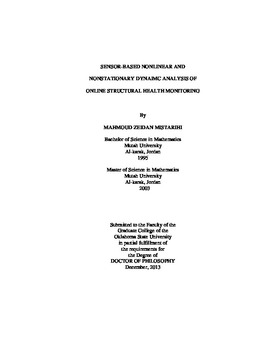| dc.contributor.advisor | Kong, Zhenyu (James) | |
| dc.contributor.author | Mistarihi, Mahmoud Zeidan | |
| dc.date.accessioned | 2015-06-17T20:07:05Z | |
| dc.date.available | 2015-06-17T20:07:05Z | |
| dc.date.issued | 2013-12 | |
| dc.identifier.uri | https://hdl.handle.net/11244/19485 | |
| dc.description.abstract | This dissertation focuses on robust online Structural Health Monitoring (SHM) framework for civil engineering structures. The proposed framework improves the diagnostic and prognostic schemes for damage-state awareness and structural life prediction in civil engineering structures. The underlying research achieves three main objectives, namely, (1) sensor placement optimization using partial differential equation modeling and Fisher information matrix, (2) structural damage detection using quasirecursive correlation dimension (QRCD), and (3) structural damage prediction using online empirical mode decomposition (EMD). | |
| dc.description.abstract | The research methodology includes three research tasks: Firstly, to formulate the optimal criteria for the sensor placement optimization damage detection problem based upon a partial differential equation (PDE) analytical model. The PDE model is derived and then validated through experimental results using correlation analysis. Secondly, to develop a novel quasi-recursive correlation dimension method for structural damage detection. The QRCD algorithm is integrated with an attractor analysis and overlapping windowing technique. Thirdly, to design an online structural damage prediction method based on empirical mode decomposition. The proposed SHM prediction scheme consists of two steps: prediction based change point detection using Hilbert instantaneous phase, and damage severity prediction using the energy index of the most representative intrinsic mode function (IMF). | |
| dc.description.abstract | Study results show that; (1) the proposed optimal sensor placement method leads to an optimal spatial location for a collection of sensors, which are sensitive to structural damage, (2) the proposed damage detection algorithm can significantly alleviate the complexity of computation for correlation dimension to approximate O(N), making the online monitoring of nonlinear/nonstationary processes more applicable and efficient; and (3) the proposed empirical mode decomposition method for online damage prediction overcomes the boundary effects of the sifting process, and it has significant prediction accuracy improvement (greater than 30%) over other commonly used prediction techniques. | |
| dc.format | application/pdf | |
| dc.language | en_US | |
| dc.rights | Copyright is held by the author who has granted the Oklahoma State University Library the non-exclusive right to share this material in its institutional repository. Contact Digital Library Services at lib-dls@okstate.edu or 405-744-9161 for the permission policy on the use, reproduction or distribution of this material. | |
| dc.title | Sensor-based nonlinear and nonstationary dynamic analysis of online structural health monitoring | |
| dc.contributor.committeeMember | Bukkapatnam, Satish T. S. | |
| dc.contributor.committeeMember | Liu, Tieming | |
| dc.contributor.committeeMember | Ley, Tyler | |
| osu.filename | Mistarihi_okstate_0664D_13028.pdf | |
| osu.accesstype | Open Access | |
| dc.type.genre | Dissertation | |
| dc.type.material | Text | |
| dc.subject.keywords | mathematical modeling | |
| dc.subject.keywords | sensor optimization | |
| dc.subject.keywords | structural health monitoring | |
| thesis.degree.discipline | Industrial Engineering and Management | |
| thesis.degree.grantor | Oklahoma State University | |
